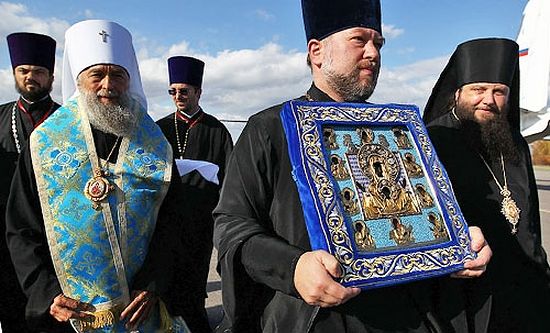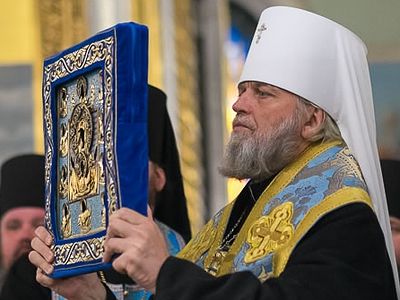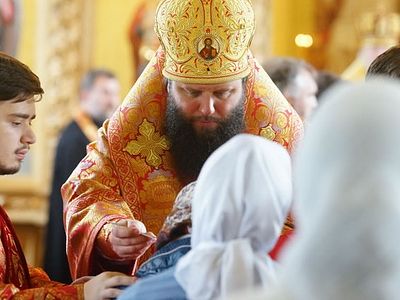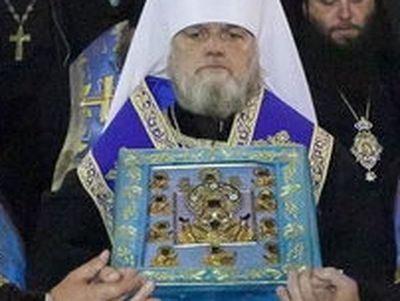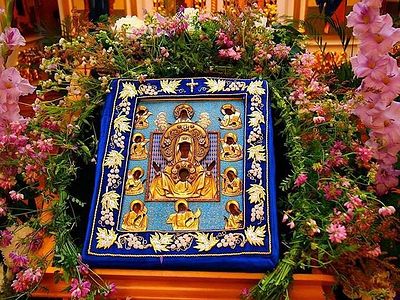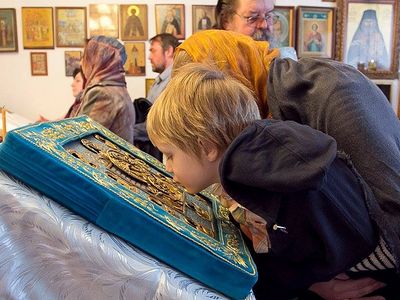Source: Official website of the Synod of Bishops of the ROCOR
Tens of thousands of believers came to venerate one of the greatest of the ancient Orthodox icons, the Kursk Root Icon of the Mother of God "of the Sign," which visited Mordovia on October 4-10, 2016. The miracle-working icon has for many years been kept in New York, and visited this region for the first time.
It was accompanied by representatives of the Russian Orthodox Church Outside of Russia, His Grace Bishop Nicholas of Manhattan and Protopriest Alexandre Antchoutine. What is the great power of this ancient image of the Mother of God “of the Sign?” Russian emigres credit this icon for their survival abroad. How has the spirituality of Russia changed in recent years? Why do native Americans convert to Orthodox Christianity? Vladyka Nicholas and Fr Alexandre talk with Stolica-s.su about these questions.
“The arrival of the Kursk Root Icon of the Mother of God 'of the Sign’ is an important historical and spiritual event for Mordovia,” said Vladyka Nicholas. “Almost as soon as we flew into Saransk, we headed for the cathedral. It seemed so grand, so bright, white and joyful. And so many people were waiting to greet the icon! It is kept at the Synodal Cathedral of Our Lady “of the Sign” in New York City, but is almost always traveling. It is great that this grace, this spiritual veil is able to visit other countries, including Russia… For me, coming to Mordovia is a great joy. This region has made a great impression on me.”
Stolica: Vladyka Nicholas, you were born and raised in the US to the family of Russia emigres. How were you able to maintain such fluent Russian and a love for Russia?
- My grandparents and parents were forced to flee Russia. They found a temporary home in Brazil. But later, some friends invited them to Rochester, NY, in the US, where a Russian parish existed, the Protection of the Mother of God Church. Not far was Holy Trinity Monastery in Jordanville, NY. Russians lived there who shared our spirit. My parents got married in Rochester, but in time moved to New Jersey for work. That’s where my two brothers and I grew up. Monday through Friday we would go to American school, but our house was a Russian house in spirit, Russian was always spoken there, our native dishes were served, we observed Orthodox Lenten periods. Mama was very religious. Our family regularly attended divine services. On Saturdays and Sundays we attended Russian school, where I had friends like us, Orthodox Christians, we studied Russian history, culture, language, and of course the Law of God.
After graduating, I enrolled in Holy Trinity Seminary in Jordanville, then continued by studies in college. In time, I was to serve under Vladyka Laurus [(Shkurla) as his personal aide, driver and Subdeacon. That God all this kept me close to the Church. In December 2010, Metropolitan Hilarion told me that I was appointed the caretaker of the Kursk Root Icon of the Mother of God "of the Sign," because it began to travel more to various countries. I moved to New York City, and my obedience began. Since then, I try to carry out my obediences zealously.
Stolica: What did you feel, having grown up with a Russian identity, when you first arrived in Russia?
- That was in 2001, when I accompanied Vladyka Laurus during one of his unofficial visits to Russia. At the time, we went to Moscow and Solovki. Yes, it was magnificent! We grew up in America, but reared in the Russian spirit. When I arrived in Russia, I sensed my roots, my Homeland. I finally saw her with my own eyes, and came to love her even more! After that, the Lord allowed me to visit Russia almost every year.
Stolica: It has been fifteen years since your first visit to your Homeland. How has our country changed since then, how has the spirituality of the Russian people changed?
- It is apparent that the Orthodox faith is growing, and becoming younger. In the cathedral in Kursk, on the day the icon left for Mordovia, a great number of clergymen served, and along with them, about 12 deacons. All of them were young men who finished seminary not long ago. May God grant that they, too, become priests in the future. I am filled with joy that there are more and more young clergymen and worshipers. The spiritual changes are obvious, and all for the better.
Fr Alexandre: Since 2009, we have taken the icon to Kursk. It is noticeable that even from that year, a great deal has changed. New churches are being built, existing ones are being renovation. For me, this is a miracle of faith, which has been rejuvenated! Before, the people who came to venerate the Kursk Icon of the Mother of God were mostly old women who knew about it; there were even some who remembered the icon when it was still in Russia. But every year, the stream of faithful coming to the icon gets younger and younger. This is not a business, or a fad, like some think. We remember that it was in fact “fashionable” to be a believer in Russia in the 1990’s. But that time has gone. People consciously go to church and take their children with them. The church in Kursk is open day and night when the icon is there. At all times of the day and night you can find parents with their children venerating the icon, pregnant women. The fact that young people are striving the venerate this icon, to adopt the Orthodox faith, is the greatest of miracles! If monasteries are opening all over Russia, this means there are monastics to occupy them. These aren’t just old ladies in kerchiefs, but young people who consciously choose this path for their lives. Faith in Russia is deepening. And this gives us great hope.
Stolica: Are Orthodox Americans much different from Russian Christians? We may share the same faith, but is the mentality different?
Vl. Nicholas: Yes, I would say there is a difference. But we are one in spirit. At the headquarters of the Synod of Bishops of the Russian Orthodox Church Outside of Russia, the Cathedral of Our Lady “of the Sign” was established, where divine services are conducted in Church Slavonic. But there is a chapel downstairs dedicated to St Sergius of Radonezh, where Liturgy is celebrated in English. That is where native Americans who adopted Orthodox Christianity mostly attend services. Most of them, of course, understand divine services better in their native tongue, though we share one faith. We also have Holy Cross Monastery in West Virginia, which is drawing more and more people, all Americans. The brotherhood there is very gregarious, yet they have a very strict monastic way of life. The abbot of the monastery, Archimandrite Seraphim once said to me “Clearly, we are all Americans. But it is an honor for us to belong to the Russian Orthodox Church. We know how worthy our hierarchs are, and how great is our legacy.”
Sometimes, American tourists visit the Cathedral of Our Lady “of the Sign” and happen upon the celebration of Divine Liturgy. Afterwards, I talk to them, I ask how they happened to visit our church. They would say “We just came in and stayed for the entire service. We understand nothing, but we feel that it is very good here. And this is where we belong!” In time, some of them convert to Orthodoxy. Now these are among the most active congregants of St Sergius Chapel, the English-language community. The Lord brings people to the faith in various ways.
Stolica: In Russia, many are baptized into Orthodoxy in childhood. We take our faith as something natural, granted from birth, and we sometimes don’t value what we have. Maybe a person who comes to the faith in adulthood looks upon it differently?
Fr Alexandre: Americans who convert to Orthodox Christianity receive our faith like children, that is, with earnestness. They regularly attend services, they study the Holy Fathers, they observe the fasts. They joyfully adopt Russian customs. For instance, they celebrate maslenitsa [cheesefare week], the Nativity and Paschal celebrations, etc.
Vl Nicholas: In Michigan there is an English-language parish which hosts an annual Russian festival.
Fr Alexandre: Yes, as they come to the faith, they start to talk in a different spiritual language. This doesn’t just apply to Americans. The Russian Church Abroad brought its ministry to all the continents of our planet. In churches of the Russian Church Abroad, they use practically all the major global languages: English, French, German, Chinese, Japanese, etc. In Pakistan there is an Orthodox mission, in Haiti we have a number of communities.
Stolica: The icon “of the Sign” over the centuries of its existence has caused many unbelievable healings and has helped a great many who appeal to the Queen of Heaven with genuine prayer. As the caretaker of this icon, have you felt its miraculous power as well?
Vl Nicholas: I know that many received help in family life, in their lives, through prayer to this image of the Mother of God. But I think that the real miracle lies elsewhere. This great holy icon has existed for over 700 years. The future St Seraphim of Sarov prayed before it, the Russian Tsars and their families. In the early 20th century, this icon accompanied the Russian emigration through all of Europe, and throughout the world. And it survives to this day. For a person outside of the Church, this 13th-century icon is a museum piece. Many people are bewildered, how is it that we travel without a security attachment? Why isn’t it in a museum under special glass and in a temperature-controlled environment? For us Orthodox Christians, we don’t worry about that. The icon is kept at the Cathedral of Our Lady “of the Sign,” but sometimes it is in my residence, or in Metropolitan Hilarion’s quarters, or taken by a priest of ours at their parish. We do this simply, without fanfare or problems. This I see as a great miracle! This holy icon travels throughout the world so much, bringing consolation to a great multitude. Today the icon is in Mordovia, in a few weeks it will be in New York. Then it will go to Canada, to France, etc. The fact that this is done so calmly is, in my opinion, through Divine intervention. And through this icon, many Americans have come to the Faith.
Fr Alexandre: Of course, one must first of all seek spiritual help in venerating this icon. And we see, as we travel throughout the dioceses with the icon, so many people benefit from healing from physical and spiritual ailments. There is a chronicle of this icon; during World War II, it was in Europe, and through the prayers of people, many miracles took place. No one died in the houses the icon visited. Countless miracles occurred! Winds would subside, locked doors would open, and so on and so forth. But of course, we should concentrate on the spiritual benefit that the Mother of God offers us through this holy icon. Hundreds of thousands of parishioners of the Russian Church Abroad deem this icon “of the Sign” as their family “heirloom.”
Stolica: Over recent decades, Mordovia has seen the renovation of many churches and monasteries which had been closed or destroyed during the godless Soviet years, new churches are being built, new cathedrals. But there are always some people who are against this effort at rebirth. Some think that a church is nothing more than four walls, and the construction of churches is a waste of money. How do we reach people like this?
Vl. Nicholas: I would like to invite everyone to our festive Paschal service. I doubt anyone would not be spiritually moved by the end of the service. It is a special time, everyone feels an unearthly grace. The Paschal service is Heaven on earth. Of course, we must knock on the door of the human heart, explain that salvation without the Church is impossible. In the fuss of daily life, people often lose their way. Life is fleeting.What is the meaning of life for someone who does not have God in his heart? Only to die at the end?
For the Orthodox Christian, life is eternal. We could discuss this topic endlessly, but if you don’t feel it in your heart, then you can’t heed the call. Come, see our Paschal service, there are people of all ages there, from infants to the aged. Ask them why they come. A great deal depends on the clergymen celebrating the services, the sermon of the priest…
Fr Alexandre: Russia is an Orthodox nation. But look what happened to her when she departed from her faith. Remember all the tragedies of the godless years. We need churches, of course, they are our spiritual centers—how did the Russian diaspora survive but with its churches? People were forced to flee, they were driven out of their country, forced out. Noblemen, officers, engineers, lawyers suddenly found themselves in a strange country, where they had to find a way to survive. They took whatever job they could find, as seamstresses, in matchstick factories, cement warehouses, etc. They lived in hovels, single rooms. But what did they do first and foremost? They gathered communities and built churches. Only then did they turn to their own well-being… That is how they survived, got on their feet, reared their children. This is an example of what happens when people unite around their faith and build churches. The Lord grants them all that they need, even in foreign lands.
Stolica: One of the stereotypes we have here is the “priest in gold driving a Mercedes.” Although thousands of priests in Russia live modestly, do clergymen in the US suffer such need as well?
Vl. Nicholas: Unfortunately, there are always people who point fingers. Every priest has to be prepared for this. When I was being ordained a priest, my spiritual father told me “Now you must know two words: humility and self-sacrifice. If anyone condemns you, don’t pay attention, just do your work.” In America, almost all of our clergymen, besides parish work, parish school, also has a civil job from Monday through Friday. Please, how is it possible to point fingers at such a person? That way of life is only worthy of praise.
Fr Alexandre: Of course, the American mass media and in society are critical of priests, and not only Orthodox priests. Catholic clerics and others are also subject to criticism; the Enemy does not sleep, and tries to divert people from the faith. I think that the condemnation of priests in Russia is a remnant of Soviet times, when everything having to do with Orthodoxy was disdained…
What is a parish? It’s not a matter of stopping by church on Sunday and light a candle. Parish life in the Russian Church Abroad is a collection of volunteers. We don’t have paid janitors, receptionists. The parishioners themselves do all the work, they take turns, and do it all out of love.
Stolica: The great tragedy of our nations is widespread abortions. Recently, Patriarch Kirill signed a petition against abortions. This sparked consternation in certain social circles. But they’re not talking about a total ban, only end the program of free abortions on demand. Many women are upset that they would be deprived of the right to kill their own unborn child...
Vl. Nicholas: Man is created in the image and likeness of God. The Gospel teaches us that a person is created at the moment of conception—it is not just a jumble of blood and cells. The Church celebrates this: for instance, the Conception of John the Baptist and the Annunciation. How can you argue against this? For a non-religious person, this reasoning is baffling. But I ask you, how is it possible to kill a helpless child?
Stolica: There is a great deal of scientific research demonstrating that all the information of the child: the color of the eyes, the hair, the shape of the nose and ears, is formed immediately upon conception. The child is already unique. There is no other person in the world who is exactly alike and never will be. In a few days, the heart begins to beat. The medical research is overwhelming! But for some reason, even such logic does not reach the hearts of mothers who choose abortion…
Fr Alexandre: Unfortunately, the contemporary propaganda on pleasure and comfort leads to doom. It’s the same in America. Not only Orthodox Christians but Roman Catholics are fighting the practice of abortion. Murder is a terrible sin! The problem is that the movement is not covered by the press. We hold demonstrations against abortion, priests of various Orthodox jurisdiction speak about this at length. Christians grieve over the depth of this sin. Sadly, those in power push a policy which contradict Christian norms as a matter of principle. Young people are taught: “Do what you want, it is your life and your body.” But a mother who murders a child in her womb, will sooner or later realize what she did. Let us hope that His Holiness and the movement against abortion in Russia will succeed in ending this terror.
Stolica: Do Americans who converted to Orthodoxy also develop a love for Russian culture and sympathy for Russia?
Vl. Nicholas: When Americans become our parishioners, then sooner or later they learn about the life of the Russian Orthodox Church, which is inseparable from the history of Russia. They come to understand why we revere the Royal Martyrs, St John of Kronstadt, and so forth. This binds them to the Russian world.
Fr Alexandre: Without delving into politics, I’d like to say this: the American people are not evil. On the contrary, they are very kind. The bad relations with Russia is not shared by the population. Real Americans are kind, simple, and open-hearted. They are always ready, as are we, to open their hearts and hearths, feed the hungry, etc. They don’t “fear the Russian bear” [smiling].
Vl. Nicholas: Sometimes I will walk out in the evening for a walk in the city, wearing my cassock and cross. New York is a vast city. Almost all who pass by say hello to me, smile warmly, seeing that I am a Christian. And during the holidays, they will always say “Merry Christmas” or “Happy Easter.”
